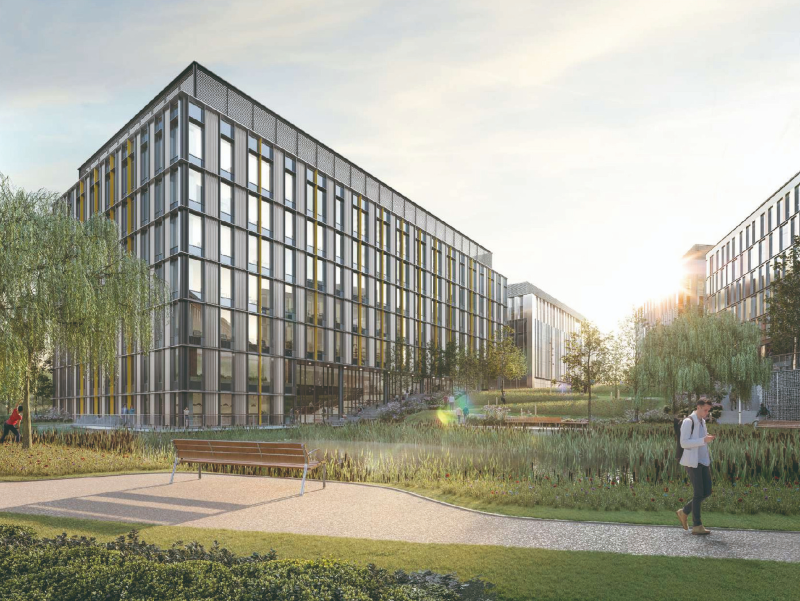Project
Expansion of the Innovation Birmingham Campus
| Client | Bruntwood SciTech |
|---|---|
| Turley office | Birmingham |
| Status | Planning permission granted |
What are you looking for?
There are currently over 100 research parks, technology parks, incubators, innovation centres and technoparks (or more simply ‘Science and Innovation Parks’) in the UK[1]; a number that is set to grow in light of the Government’s ‘Silicon Valley’ intentions.
As areas for research, training, and pushing forwards the boundaries of knowledge, can science and innovation parks help us to achieve our net zero goals?
Science and innovation parks can certainly act as a hotbed for new ideas and pioneering low carbon technologies. For example, The BRE Innovation Park Network [2] has been established to test full scale demonstration buildings utilising innovative materials and technologies, with the aim of informing worldwide sustainable development.
Exeter Science Park’s £5 million George Parker Bidder building, which opened its doors in January 2022, has been built to net zero carbon standards following the Green Building Council’s definition of net zero carbon in use. The ultimate aim of this science park is developing “carbon negative” buildings that generate more power than they use.
At Turley, we have worked closely with Bruntwood SciTech on their Enterprise Wharf and Birmingham Health Innovation Campus (BHIC) schemes. Enterprise Wharf is Birmingham’s first ‘smart-enabled’ buildings, which brings together Building Management systems, Heating Ventilation and Air Conditioning systems (HVAC), lighting, CCTV, and energy data to increase efficiency and reduce energy use.
Science and innovation parks are often ideal areas for solar generation, and increasingly, microgrids provide the opportunity for whole parks to act as a single energy system; interacting with the wider energy system and markets to reduce pressure on the grid whilst reducing bills for occupiers.
The co-location of various uses within these parks (such as offices, laboratories, research hubs, and training facilities) not only stimulates productivity and innovation in the sector, but can act as a means of improving operational efficiency through the grouping of activities and supply chains.

On the other hand, science and innovation parks face many challenges along the road to net zero.
While the work done in laboratories often focuses on finding solutions to global health and environmental challenges, energy use within some laboratories can be ten times higher than a standard office building. Securing sufficient grid capacity is already one of the biggest challenges in bringing forwards these sites. Where net zero goals result in the electrification of heating and transport, electricity demands will further increase and conversations with local utility providers will be essential. As with Bruntwood SciTech, our work has shown that a smarter approach to energy management for buildings and electric vehicle charging can help to reduce peak demand, network issues, and associated costs.
With many science and innovation parks located on the edge of cities, low-carbon travel options will be essential to ensuring that transport-related emissions don’t counteract the benefits brought about by advanced low carbon buildings and technologies. Mobility hubs which offer bike and scooter rentals, charging facilities, car clubs, and good public transport connections can enable out of town locations to be accessible without the need for a huge car park. For new science and innovation parks, sustainable transport options will play a key role in the sustainability strategy for the site. Early engagement with the development design team, the local planning authority, and local transport providers can help to ensure the success of sustainable transport initiatives.
It important that we consider what constitutes ‘net zero’ for these sites, especially given that the majority of emissions from a science and innovation park will be associated with transport and unregulated energy (such as IT equipment, lab equipment, and catering facilities), which are often not included in net zero accounting. This is an issue our Sustainability team often considers and two of our team members have recently been appointed to a cross-industry initiative to develop the UK’s first Net Zero Carbon Buildings Standard, which will help to provide some clarity around what ‘net zero’ means for buildings in the UK.
In summary, although science and innovation parks face several challenges along the path to net zero, they are also a source for new ideas and pioneering low carbon technologies. Through a combination of electrification; smart energy management; renewable power generation; new mobility solutions; and data collection and analysis, science and innovation can play a key role in showing the wider world the steps we need to take to get to zero.
For more information on how we can support your net zero science and innovation park projects, please get in touch with Lizzie Bolton.
23 November 2022
[1] Innovation, research and development grants
[2]BRE Innovation Parks Network
| Client | Bruntwood SciTech |
|---|---|
| Turley office | Birmingham |
| Status | Planning permission granted |
7 November 2022
Two members of our Sustainability team have been appointed to a cross-industry[1] initiative to develop the UK’s first Net Zero Carbon ...
| Client | Bruntwood SciTech |
|---|---|
| Turley office | Birmingham |
| Status | Planning permission granted |